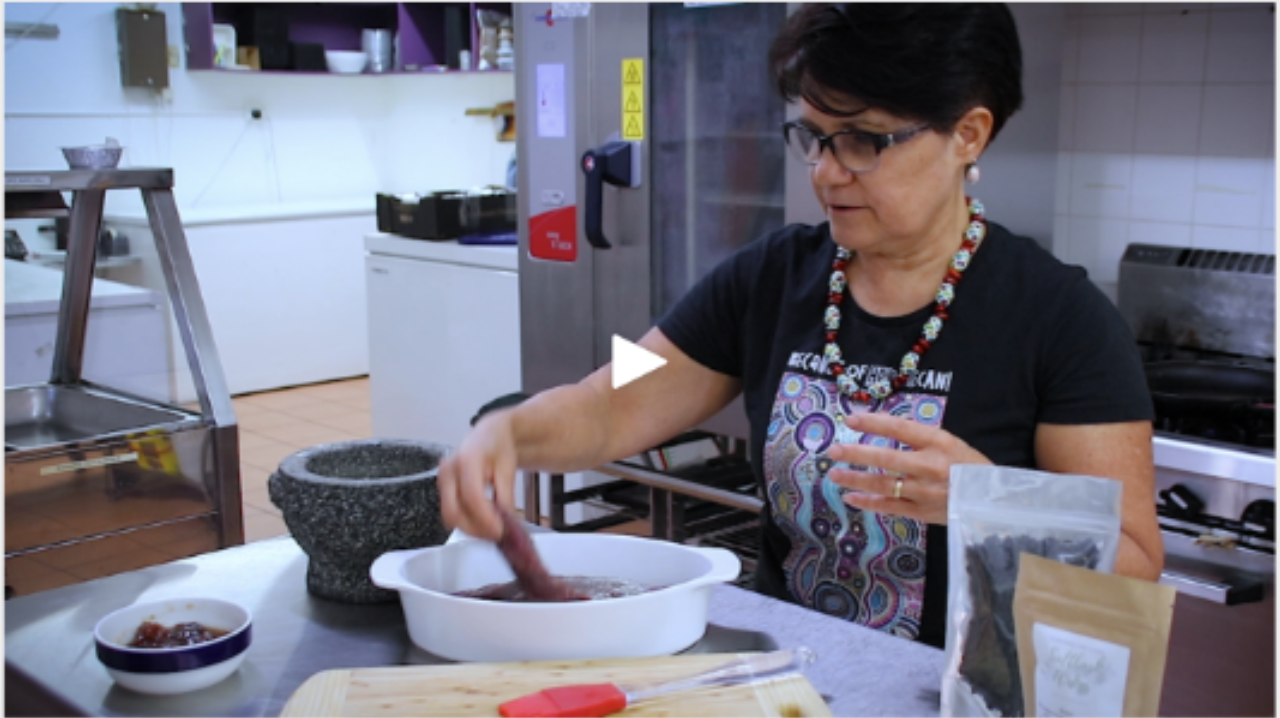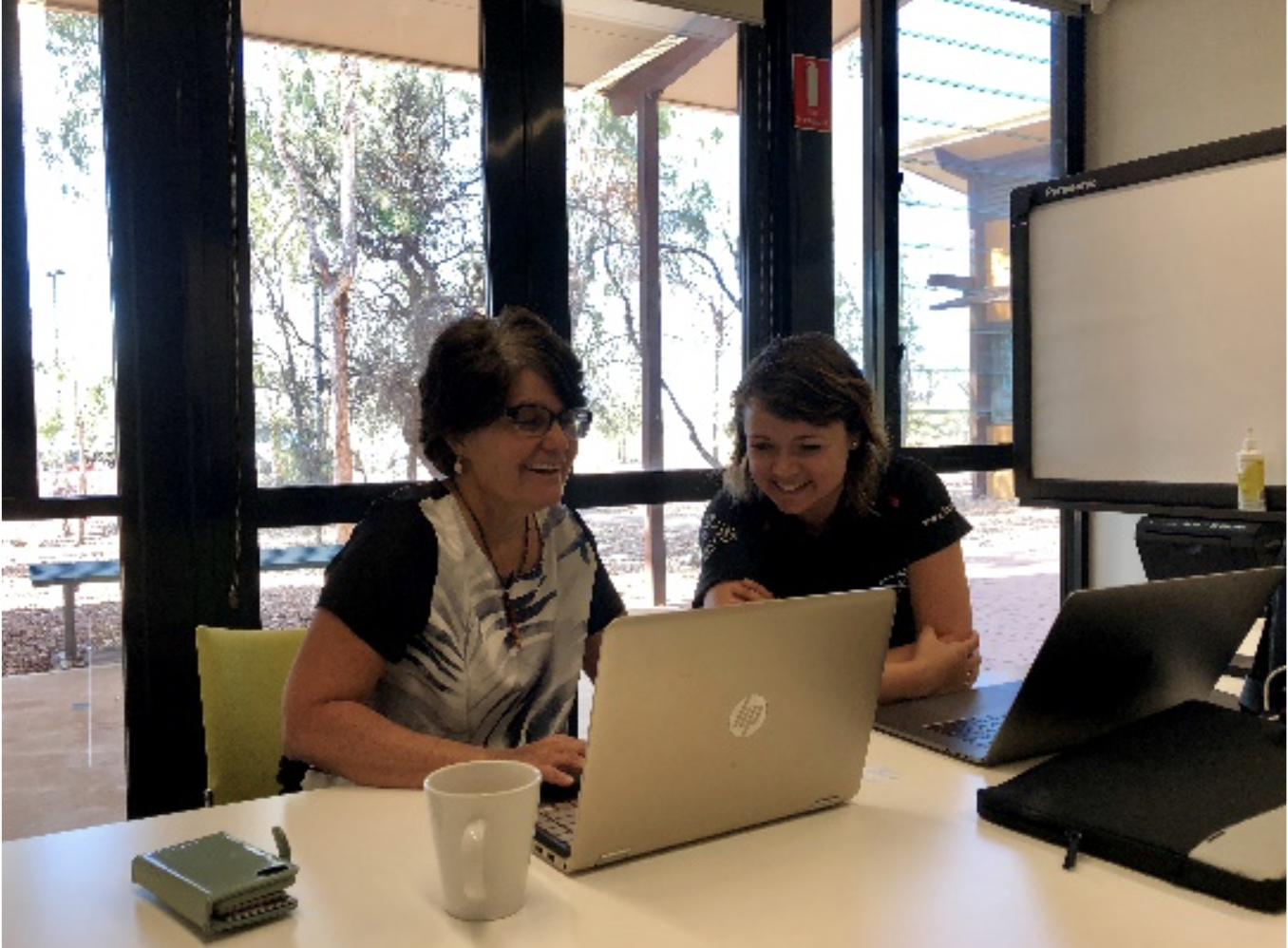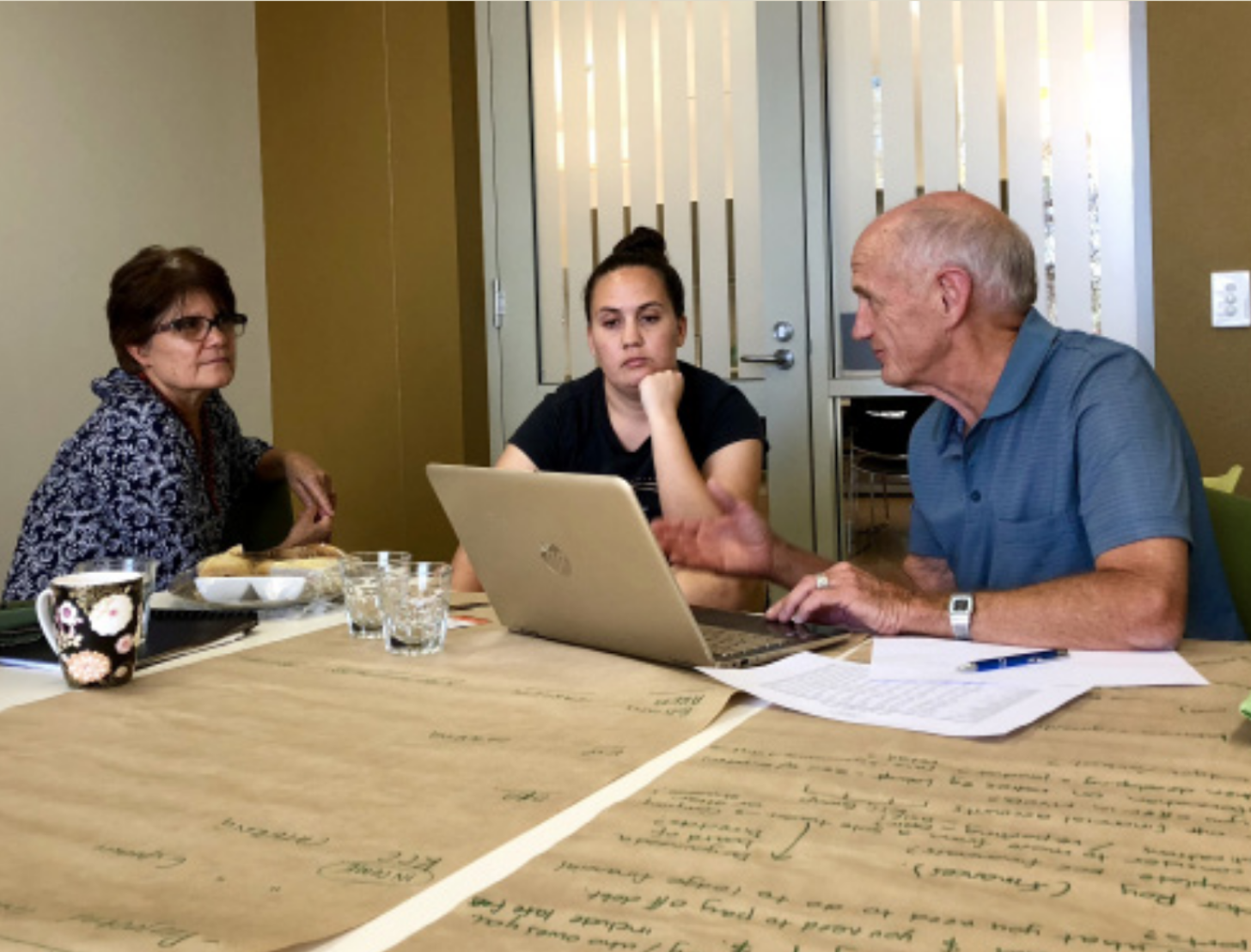Evaluating with Kungkas Can Cook: passion, dedication and clear social purpose
Context
Kungkas Can Cook is a café, catering and bush foods business based in Alice Springs, specialising in ethically sourced, organic bush food from the Central Desert.
Kungkas Can Cook, Rayleen Brown with Community First Development volunteer Deborah Stanley gathering content for the new website.Kungkas Can Cook has a strong social purpose and promotes foods that have been enjoyed by Aboriginal communities for over 60,000 years. Kungkas Can Cook have shortened the supply chain so that local women harvesters benefit from every purchase.
For more information on the journey of Kungkas Can Cook, and the social purpose of the business, visit: https://kungkascancook.com.au/first-farmers
Evaluation and community development with Community First Development
In the first half of 2019 Kungkas Can Cook (further referred to as ‘Kungkas’) worked with Community First Development on two community development projects: 1) to increase efficiency of financial processes; and 2) to develop an e-commerce website that reflects the voice and social purpose of the business.
The monitoring and evaluation process Community First Development and Kungkas used as part of these projects is outlined below. Firstly, the approach and community benefits of the approach are discussed, secondly, the findings and the benefits of how they were applied.
How was the evaluation conducted?
How did the evaluation approach benefit the community?
The monitoring and evaluation (M&E) operated within Community First Development’s community development cycle of (1) shared understanding (2) engage and empower (3) connect and build (4) design and deliver and (5) reflect and celebrate. The practical application of this approach while working alongside Kungkas is outlined below.
1. To begin with, Community First Development spent time getting to know Rayleen Brown, the founder, and team at Kungkas. Informal discussions were used to recognise and identify strengths, values, passions, long-term aspirations and barriers that Kungkas wanted to overcome. Community First Development only engages with community members on any of their projects or evaluation of projects when invited by them. Following this initial engagement, Kungkas invited Community First Development to work with them.
The engagement built a strong relationship and understanding between Community First Development and Kungkas about what both organisations do and how they work. This provided an opportunity to determine whether it was a good fit to work together or whether other providers / services might be more suitable. In the end it was Kungkas’s decision whether or not to work with Community First Development.
“Working with Community First Development, it’s a really different experience to working with other support services for people in small business or Indigenous business. Usually, you have to work within their frameworks and their way of working. But with Community First Development you have more of a chance to model things the way you want, or to move at the pace you want to work. Whether it’s fast or slow, it seems that Community First Development can do both”.
— Rayleen Brown, Kungkas Can Cook founder
Community First Development worked respectfully, using a strengths-based approach. For example, Community First Development identified that Rayleen is a strong business woman, an inspiring presenter, has a wealth of knowledge of the bushfoods industry nationally and across communities in the central desert, has strong national networks and with many remote communities and has a great reputation in Alice Springs where she operates her café. These strengths were the focal point of discussions. Kungkas found this approach affirming and encouraging. It built trust.
“[When working with Community First Development] you can be open in what you’re saying, and be open in the direction you want to go in. And, by working together to decide on the goals for the project, it made me realise that we’re not starting from the start, that I had already done a lot of the work, but just needed some support to get to that next level.”
— Rayleen Brown, Kungkas Can Cook founder
Early engagement was also used to identify the short and long-term aspirations of Kungkas. The dream is connected to the passion and drive of Kungkas and it is the ‘fuel’ that keeps the founder and team going.
2. Engagement continued through yarning and transect walking around the café premises and surrounds pointing out key elements of the business and areas of growth. This provided an informal and relational introduction to aspects of the business, products and significance of different bush foods. These findings were recorded as observations. The projects and dream create a purposeful reason for Community First Development’s continued engagement with Kungkas, and Kungkas identified how Community First Development support could benefit their organisation and the communities they work with. The evaluation was co-designed together with the project. As well as the benefits of a practical project that would deliver results, Community First Development explained how M&E would be conducted throughout, and the benefits of incorporating M&E into the project: keeping the project on track and adjusting the approach based on what was found through doing the M&E work. The M&E plan included two data collection points: one at the beginning of the projects and one at the end.
Community First Development provided expertise on community and business development and Kungkas provided expertise on the intricacies of the communities they work with, their business and their customer base. An important part of the design process was to understand the short and long-term aspirations of Kungkas and ensure that each project would be connected and build toward the long-term dream. Based on informal conversations on Kungkas priorities, a set of project objectives and short term (project) indicators and long term (dream) indicators were co-developed. A ‘seed to tree’ scale was used to collect a baseline (quantitative) and a brief comment (qualitative) for each indicator.
The project co-design process was used to ensure that the projects aligned with the priorities of the community. Objectives acted as clear goal posts for what Kungkas wanted to achieve. Indicators recorded what Kungkas wanted to see change. These formed the project plans for the two projects.
“I find that really great, that process that you are taking me through, step by step. It’s not been that you guys are lifting me up, but you’re walking beside me. That’s how I feel it is, it’s a walk beside thing.”
— Rayleen Brown, Kungkas Can Cook founder
3. The project plan was used to connect to the most suitable volunteers for each of the projects. Kungkas decided which volunteer to work with by reviewing volunteers’ CVs, connecting over the phone for an informal interview and discussing recommendations with Community First Development. The project and M&E plan fast-tracked the volunteers’ engagement with Kungkas – the volunteers arrived on the scene knowing Kungkas’ priorities.
Getting to speak to Deb [the volunteer] over skype, and see her face was great! It feft like I already knew her and that she was part of the Kungkas family. I trusted her and that she would be the right person to work with us.”
— Rayleen Brown, Kungkas Can Cook founder
4. Delivery of the projects was centered on the objectives and indicators. The volunteers stuck to the project brief. The high level project plan created the scaffolding for finer design of the project using the volunteers’ industry expertise. In the case of the accounting project, the volunteer provided advice and guidance on how to design Kungkas’ accounting system for maximum efficiencies. In the case of the website, the volunteer provided advice on website structure, curation and development of copy to optimise communication and marketing.
Volunteers leveraged off the engagement and understanding Community First Development gained through the early phases of the project. This saved Kungkas time and energy. The detailed understanding Community First Development had gained allowed the volunteers to work respectfully and sensitively, using a strengths-based approach while targeting support to the area identified by Kungkas.
“When I showed Rayleen the draft project plan based on our conversations, her eyes just lit up with surprise and relief, and she said how rarely people really listen to try to deeply understand her and her business. She was really glad our volunteer Roy would have this information, as she often felt like she had to repeat herself over and over for other support services.”
— Maddi Ginnivan, Community First Development, Community Development Officer
Working to a co-designed project and M&E plan provided transparency and accountability to Kungkas: Community First Development and the volunteers knew their contribution would be assessed against the Key Performance Indicators (KPIs) that the community had identified and designed.
“It’s like a step by step process, and you get to look at each step that you are taking. It’s like you’re growing, and growing, and then all of a sudden you’re there!”
“I was a tree with a little branch. I felt like I knew a bit about it [the finances], but now I understand a lot more about what needs to be done. I wasn’t confident at the start, but I am now and it’s prompted me to do this work. I feel a lot better now, I feel like I’ve grown a few more branches!”
— Rayleen Brown, Kungkas Can Cook founder
5. In the final stage of the M&E work for each of the projects, monitoring data was collected using the ‘seed to tree’ scale for the project indicators. A quantitative rating was captured and alongside that, an adaptation of the ‘most significant change’ and ‘appreciative inquiry’ techniques were used to gather qualitative data through semi-structured interviews with community members. Other data collected included observations of the Community First Development - Community Development Officer, who was conducting the evaluation and who managed the project, and assessments from Kungkas and the volunteers.
Having two monitoring points for the projects (start and end) enabled a clear comparison and highlighted what had changed in the project (see more details below). This was a source of encouragement and an intentional approach to celebrating the wins. Areas for future improvement were also identified (see more details below).
Providing the three perspectives as part of an internal assessment allowed for triangulation while still operating within the scope of the project and within the approach agreed with Kungkas.
At the end of each project, the Kungkas’ dream was revisited, and the dream indicators assessed to see which indicators progressed and which required renewed attention. These findings inform future project design and aid the Community Development Officers and communities to prioritise the focus of the next project.
“Rayleen and I have found that mapping out her long term goals on a big timeline works really well at the end of each project, as it helps her to work backwards and make decisions about what the next priority is”
— Maddi Ginnivan, Community First Development - Community Development Officer
What were the key findings?
What changes happened as a result?
At the end of the project, significant progress was noted against Rayleen’s project indicators for financial literacy, self-efficacy regarding communicating with the financial sector, and knowledge of tax accounting processes. Rayleen felt confident to tackle the tasks at hand, and was clear on what work needed to be done from there on out.
A six-month post project assessment further showed that the project resulted in Rayleen having the knowledge and confidence to ensure she is receiving a higher quality of service from the financial services her business contracts, as well as receiving financial support from other sources based on the action plans identified during the project.
The ongoing discussions and capacity strengthening between Rayleen and the volunteer throughout the project organically identified areas of further growth, and there was opportunity for this to be addressed in the final assessment by the community. Rayleen identified a new goal of wanting to increase Kungkas use of budgeting and financial reporting. As a result, Community First Development is working with the same volunteer to develop a new project in the coming months, thus utilising an Action Research methodology of continued learning, implementing, evaluating and adjusting in partnership with the community.
Similarly, the assessment of the Kungkas Can Cook Website project showed an average 80% increase achieved against Rayleen’s three project indicators. These included the quality and quantity of content on the website, the functionality and integration of the e-commerce store into their operational processes, and their team’s digital literacy. The volunteer worked with Rayleen to identify a plan for continued learning to achieve the remaining project goals, and Rayleen identified another new project focusing on digital marketing which will be completed later this year.
Acknowledgements
We recognise the work of Community First Development, Community Development Officer, Maddi Ginnivan and Community First Development volunteers Roy Davenport and Deborah Stanley who offered their skills, time and support to progress the aims of Kungkas Can Cook.
We also acknowledge the team at Kungkas Can Cook, particularly Rayleen Brown for sharing her stories, business and industry knowledge and intimate knowledge of bush foods.
We thank the women who continue to harvest bush tucker in their communities and recognise their continuing connection to story and Country as they gather the foods.
To find out more about Kungkas Can Cook and to view their bush food product range, please head to their website and sign up to their newsletter: https://kungkascancook.com.au
Ethical practice
More information on how ethical principles are put into practice can be found here
Video blogs were developed with the Community First Development volunteer, training in videography and communications was included as part of the project
As part of the project, the Community First Development volunteer and Rayleen worked together to take photos for the e-commerce store, training in photography for future product cataloguing.
Rayleen from Kungkas Can Cook and Community First Volunteer, Deb, worked closely together to develop the content for the website to ensure the content was in Rayleen’s words - that it was her story.
Financial planning in action with the Kungkas Can Cook team, Rayleen Brown and Cherie Reid, with Community First Development Volunteer Roy Davenport.




